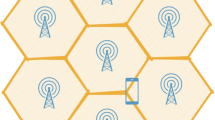Abstract
The first third-generation (3G) systems are going to be implemented within the year 2001. Academia and industry are, however, already looking for means to improve the system performance further. Spectral efficiency and higher data rate are the goal. In order to achieve this goal, several means have to be combined. The most important of these are interference cancellation and multiuser detection, optimum space-time processing and adaptive modulation and coding. In the future several wireless systems having different performance characteristics, system structure and parameters will exist. This heterogeneity will make the seamless handover from system to system difficult if not appropriately solved. 4G (fourth generation) is an acronym without any generally accepted concept. We describe some desirable goals and features of the 4G systems.
Similar content being viewed by others
References
R. Prasad, CDMA for Wireless Personal Communications, Norwood MA: Artech House, 1996.
R. Prasad, Universal Wireless Personal Communications, Norwood MA: Artech House, 1998.
T. Ojanperä and R. Prasad, Wideband CDMA for Third-Generation Mobile Communications, Norwood MA: Artech House, 1998.
R. Prasad, W. Mohr and W. Konhäuser, Third-Generation Mobile Communication Systems, Norwood MA: Artech House, 2000.
V. Tarok, N. Seshadri, and R.C. Calderbank, “Space-Time Codes for High Data Rate Wireless Communication: Performance Criteria and Code Construction”, IEEE Transactions on Information Theory, Vol. 44, No. 2, pp. 744–765, 1998.
J.-B. Andersen, “Array Gain and Capacity for Known Random Channels with Multiple Element Arrays at Both Ends”, IEEE Journal on Selected Areas in Communications, 2000, to appear.
G.J. Foschini and M.J. Gans, “Capacity when Using Multiple Antennas at Transmit and Receive Sites and Rayleigh-Faded Matrix Channel is Unknown to the Transmitter”, in J.M. Holtzman and M. Zorzi (eds), Advances in Wireless Communications, Kluwer Academic Publishers, 1998.
P.W. Wolniansky and G.J. Foschini, G.D. Golden and R.A. Valenzuela, “V-BLAST: An Architecture for Realizing Very High Data Rates over the Rich-Scattering Wireless Channel”, invited paper in Proc. ISSSE-98, Pisa, Italy, Sept. 29, 1998.
G.J. Foschini, “Layered Space-Time Architecture for Wireless Communication in a Fading Environment when Using Multi-Element Antennas”, Bell Labs Technical Journal, pp. 41–59, 1996.
R. Srinivasan, M.J. Heikkilä and R. Pirhonen, “Performance Evaluation of Space-Time Coding for EDGE”, to appear in ICC 2001 proceedings.
R. van Nee and R. Prasad, OFDM for Mobile Multimedia Communications, Norwood MA: Artech House, 2000.
Author information
Authors and Affiliations
Rights and permissions
About this article
Cite this article
Lilleberg, J., Prasad, R. Research Challenges for 3G and Paving the Way for Emerging New Generations. Wireless Personal Communications 17, 355–362 (2001). https://doi.org/10.1023/A:1011246330050
Issue Date:
DOI: https://doi.org/10.1023/A:1011246330050




